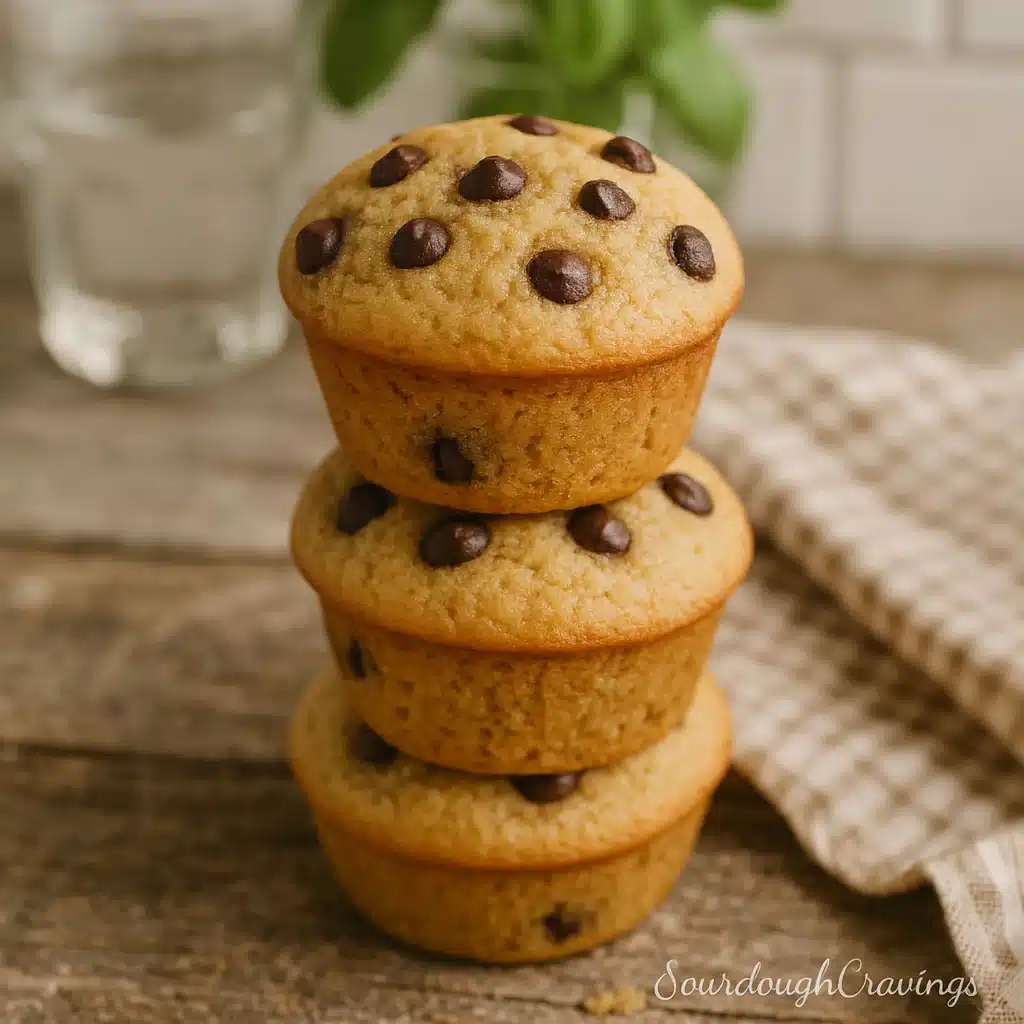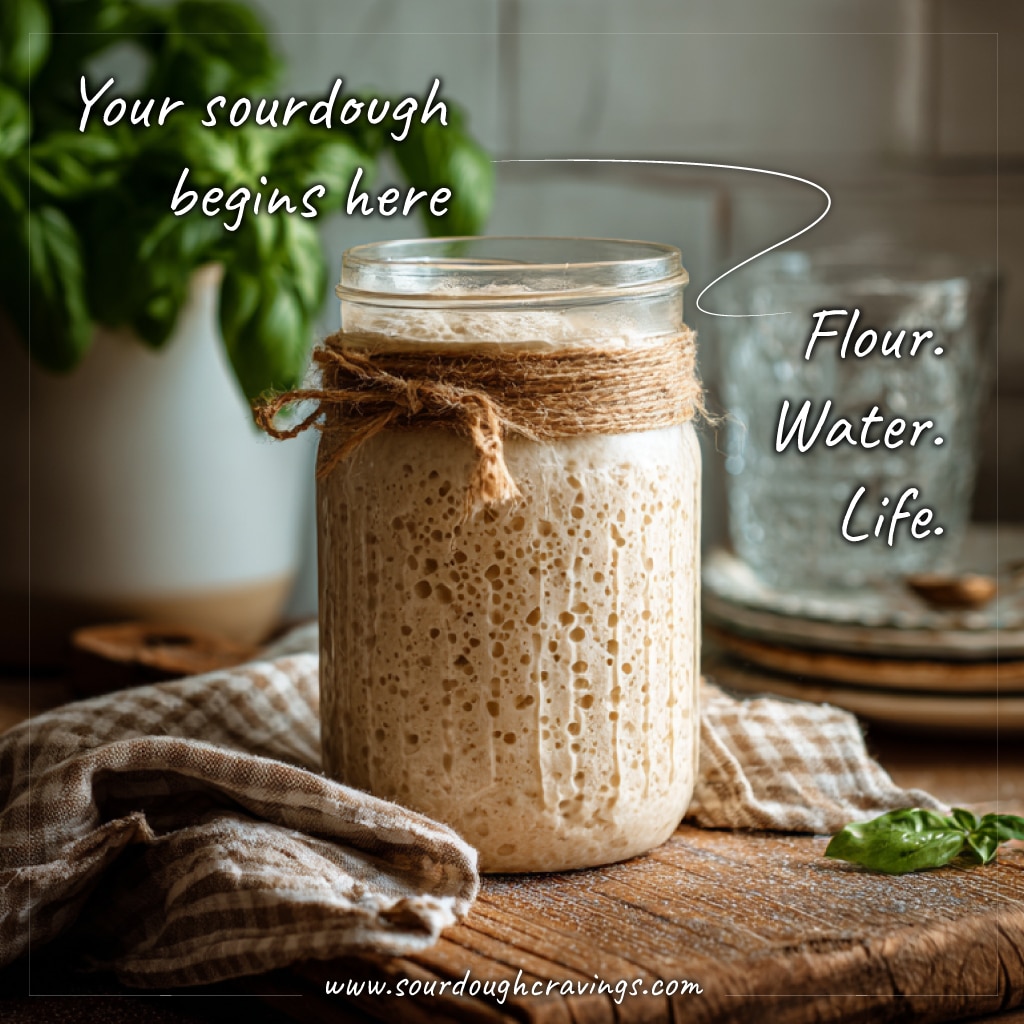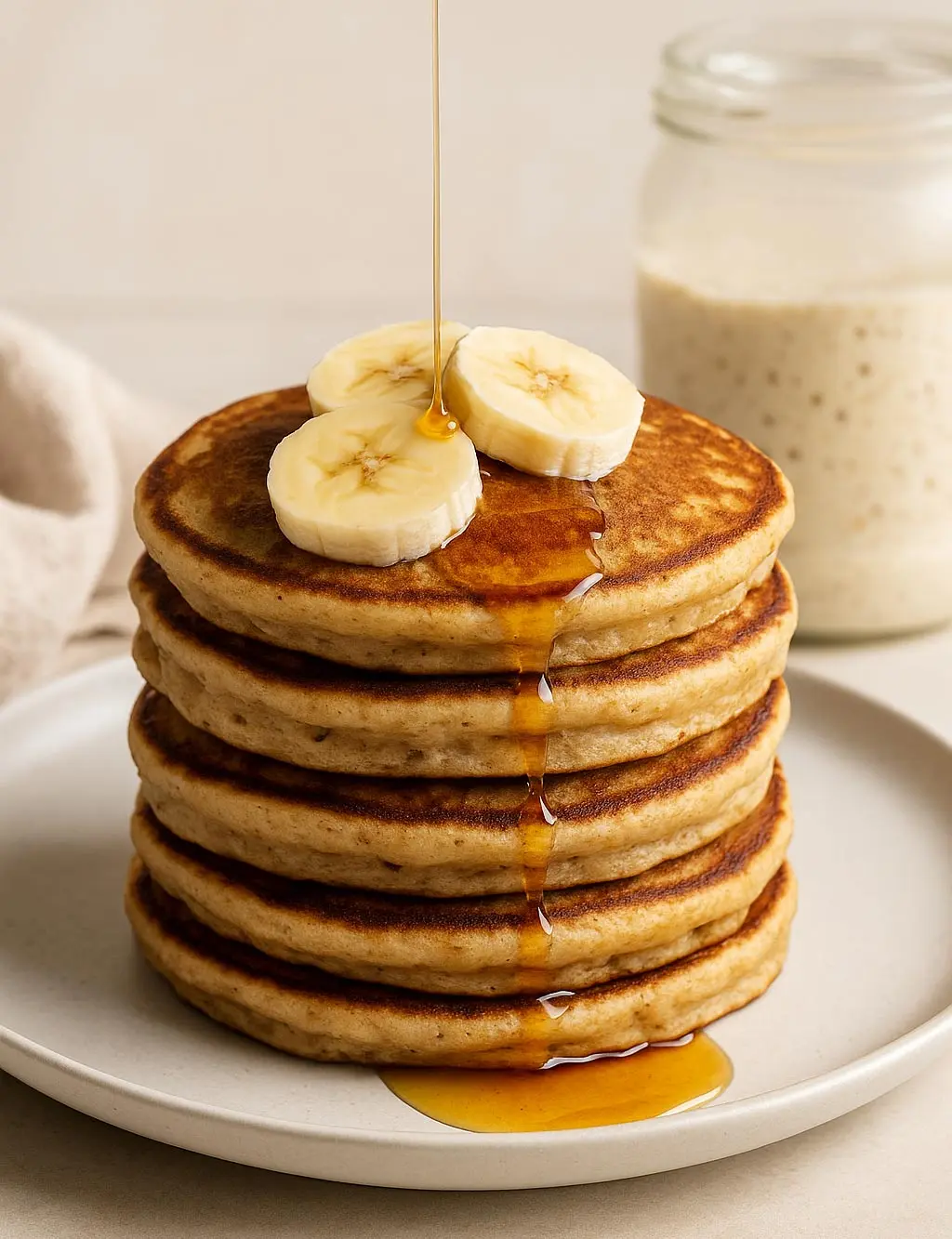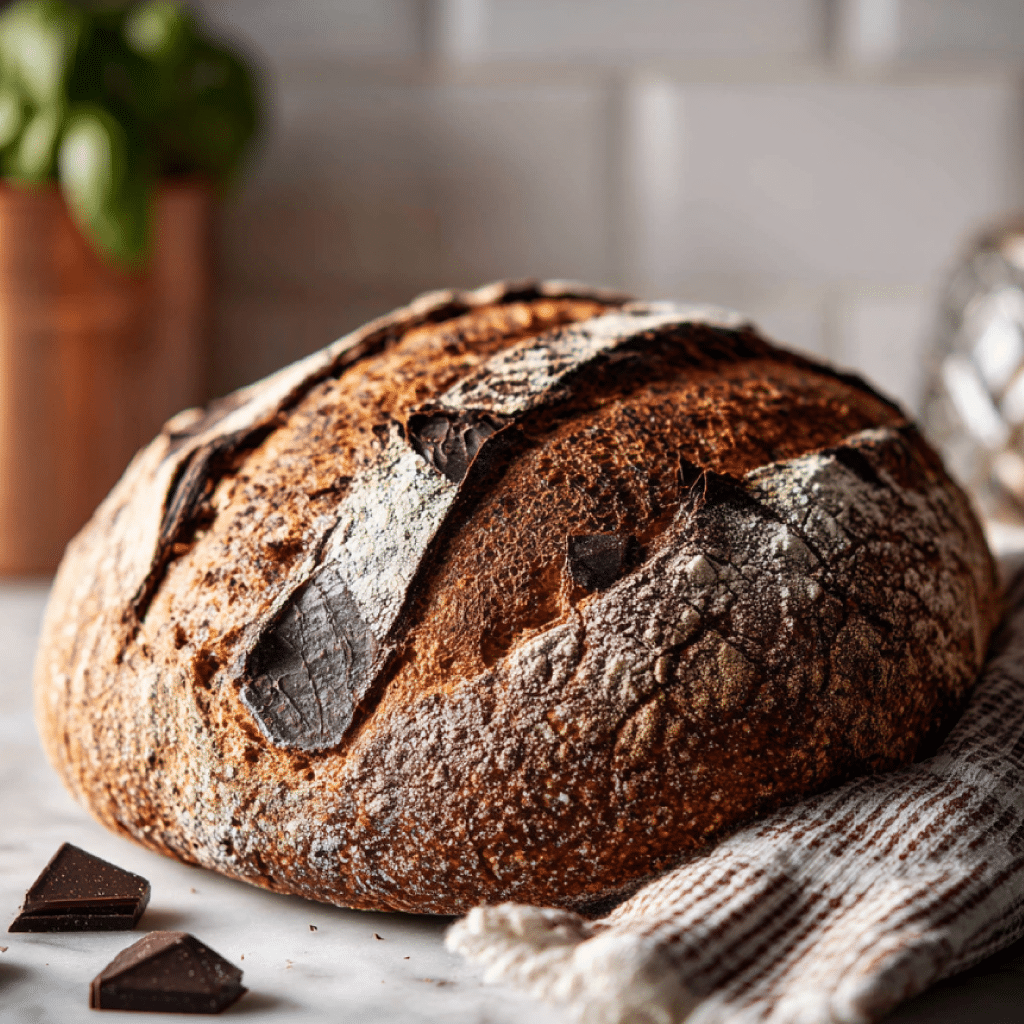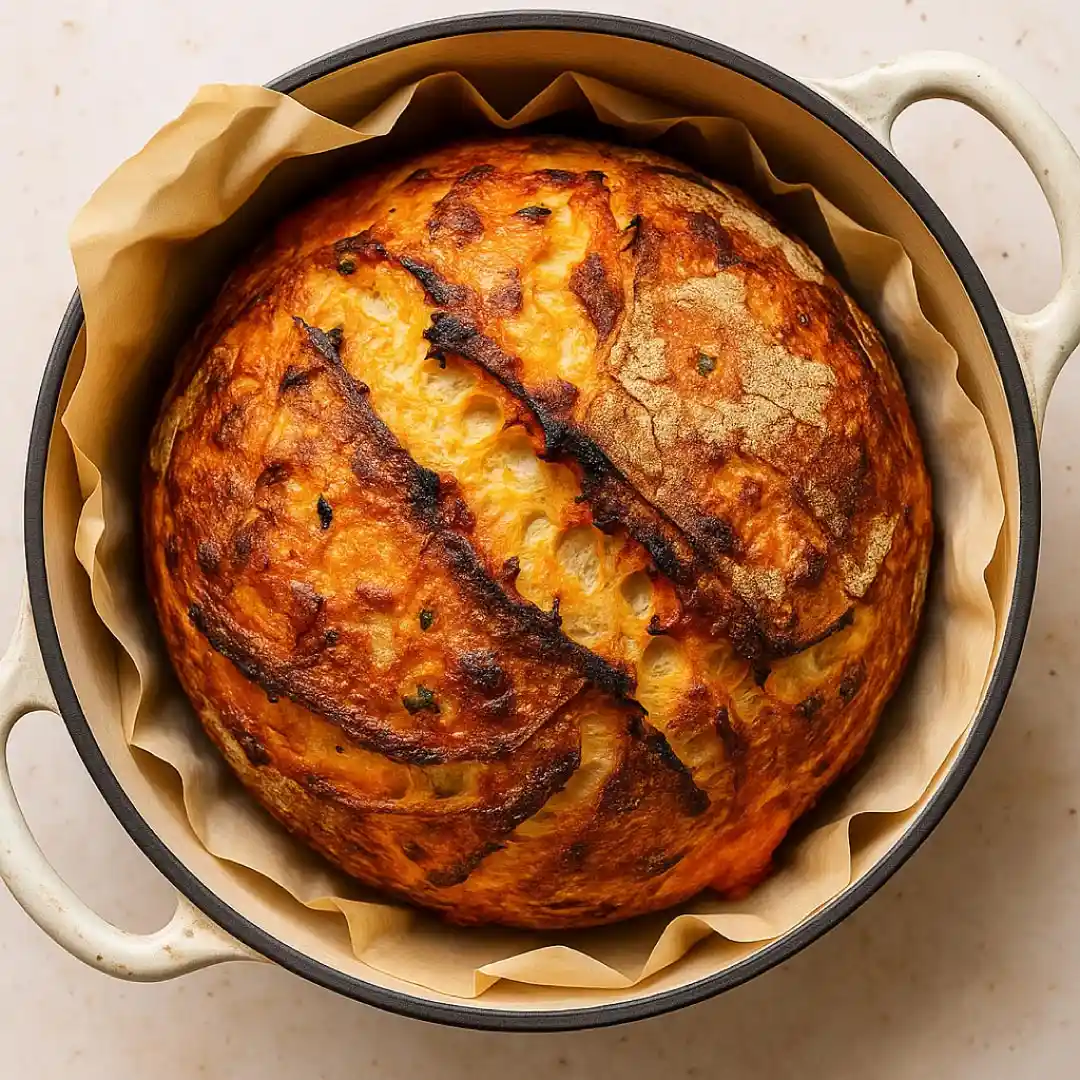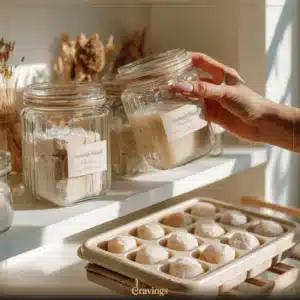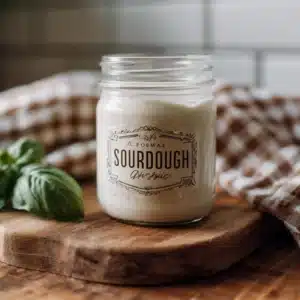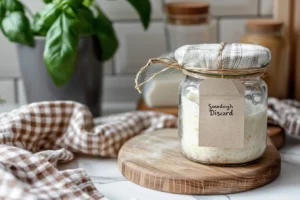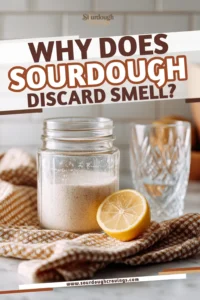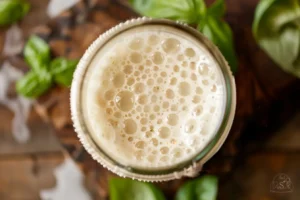Understanding the Mysterious “Sourdough Discard”
If you’ve ever started your sourdough journey, you’ve probably stared into that jar of sourdough discard and thought, “What even is this stuff — and why am I throwing away perfectly good starter?”
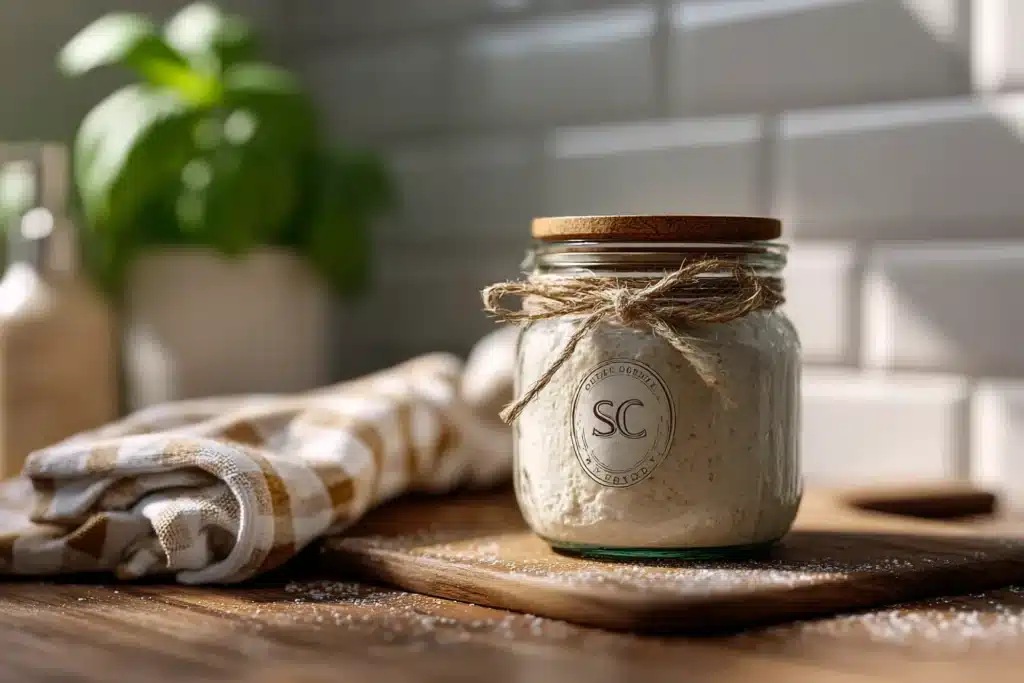
You’re not alone. I remember that moment vividly — my first week of sourdough baking ended with me pouring what looked like pancake batter down the sink, wincing with guilt. It smelled sour, almost cheesy, and I couldn’t shake the feeling I was wasting something important.
Here’s the thing: sourdough discard isn’t waste.
It’s a natural, healthy byproduct of keeping your sourdough starter balanced and thriving. Once you understand what it is — and why it’s essential — you’ll see that discard is actually one of the most useful ingredients in your kitchen.
In this guide, I’ll break down:
- Exactly what sourdough discard is (and isn’t)
- Why it exists in your feeding routine
- How to use and store it safely
- And a few of my favorite ways to make it delicious instead of disposable
Let’s dig into the simple truth behind sourdough discard — and why this misunderstood mixture is the quiet hero of your sourdough routine.
Table of Contents
What Is Sourdough Discard?
Let’s clear this up once and for all — what is sourdough discard?
Simply put, sourdough discard is the bit of starter you scoop out and set aside before giving your starter its next “meal” of flour and water. You’re not doing anything wrong by removing it — in fact, this step keeps your starter balanced, healthy, and happy.
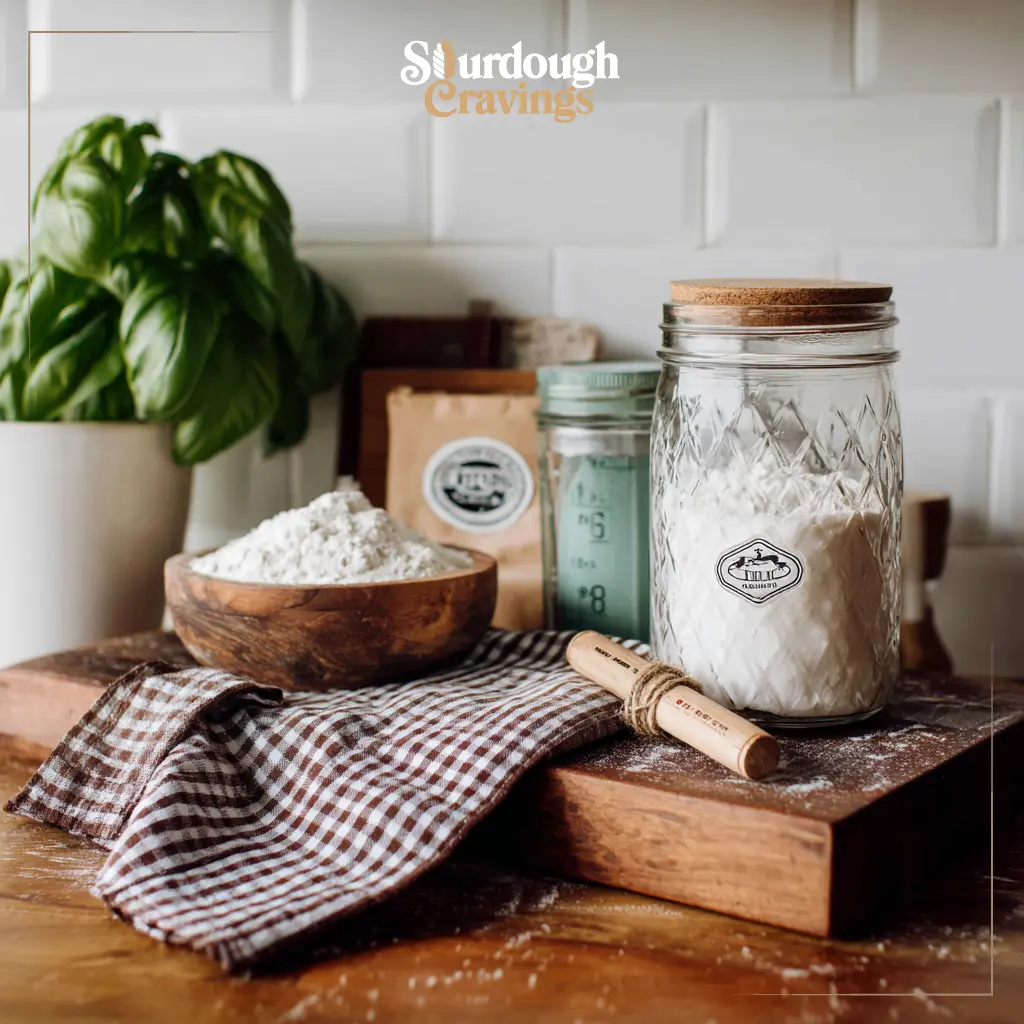
Think of your starter as a little ecosystem of wild yeast and friendly bacteria. Every time you feed it, that community multiplies and needs room to grow. If you never removed any, the mixture would just keep expanding until it turned too sour, sluggish, and hard to work with.
When you take out some of it — the discard — you’re really just keeping the culture in check. It’s like trimming a plant so it keeps producing new, strong leaves instead of choking itself out. The part you remove isn’t “bad” or “spoiled.” It’s still alive, just unfed, which means it will slow down and become less bubbly over time.
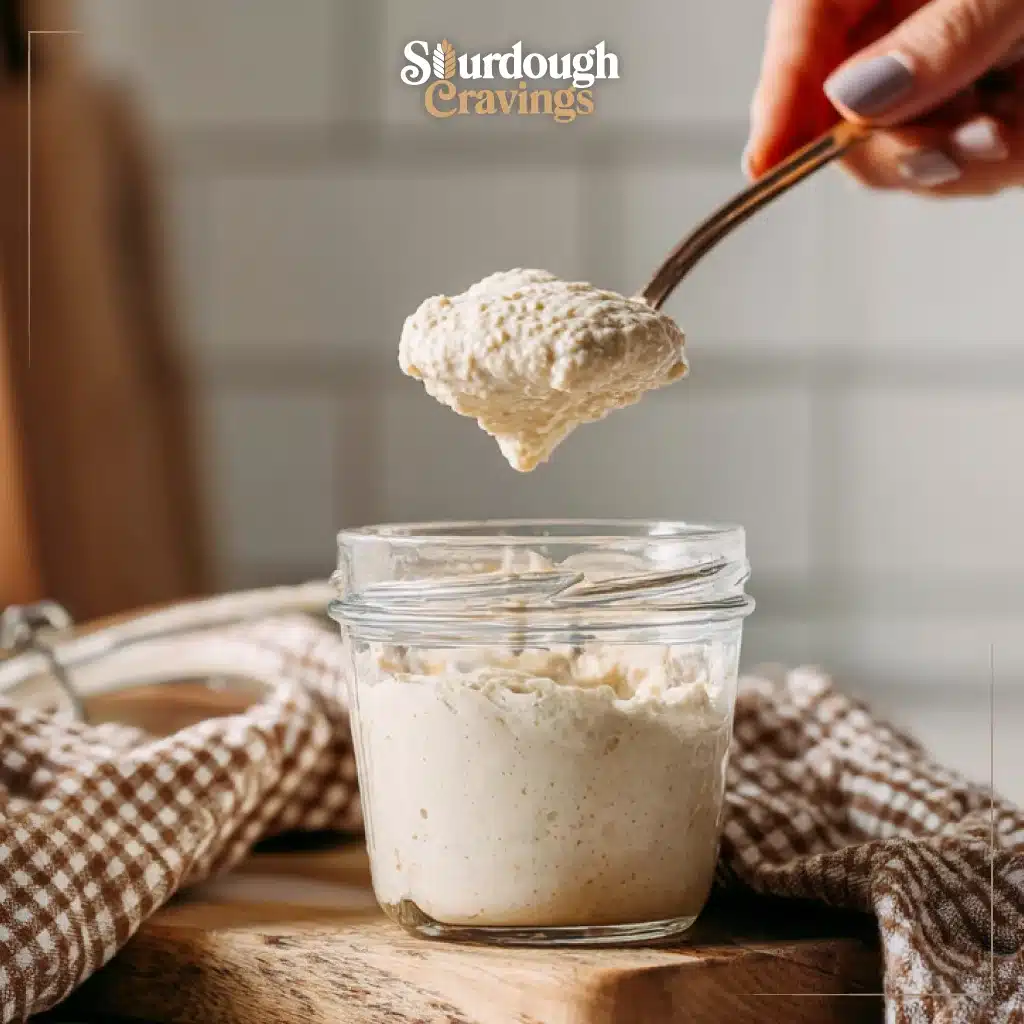
As The Perfect Loaf’s starter primer points out, the portion we call “discard” is just the unfed part of the culture that keeps the rest thriving — it’s not waste at all.
Here’s the part most new bakers don’t realize: “discard” doesn’t actually mean trash.
That portion you remove is still packed with flavor, wild yeast, and natural tang. It can be stored, baked into recipes, or even used to kick-start compost or feed other starters. Once you learn what to do with it, you’ll see that sourdough discard isn’t waste — it’s a gift.
Quick Summary:
- Sourdough discard = the unfed portion of your starter, removed before feeding.
- It keeps your starter from becoming too acidic or unmanageable.
- It’s still alive — just resting until you use it again.
- You don’t have to throw it away; you can bake, store, or reuse it in countless ways.
Related Reads:
- Sourdough Discard 101 – the full foundation for everything discard-related
- How to Store Sourdough Discard – simple ways to keep it fresh for days or weeks
- Can You Eat Raw Sourdough Discard? – what’s safe, what’s not, and why it matters
Why Sourdough Discard Exists (and Why You Actually Need It)
Every time you feed your sourdough starter, you’re keeping a tiny world alive — a mix of wild yeast and good bacteria that thrive on flour and water. Over time, though, that jar fills up fast. If you just kept adding more and more without removing some, your starter would grow endlessly and eventually lose its balance.
That’s where sourdough discard comes in.
Discarding part of your starter before feeding isn’t wasteful; it’s maintenance. By removing a portion, you’re giving the remaining starter enough fresh food to stay active and strong. It’s like pruning a fruit tree — you cut back a little to encourage healthier, more productive growth later on.
For a deeper look at how wild yeast and beneficial bacteria stay in balance inside a starter, King Arthur Baking’s complete sourdough guide explains the science behind feeding and discarding in clear, beginner-friendly terms.
If you skip this step, your starter can become sluggish, overly acidic, or even start to smell off. The yeast gets outnumbered by bacteria, and suddenly your once-lively mixture turns into something flat and dull. Feeding without discarding is like serving a never-ending buffet — sooner or later, the guests (in this case, the microbes) stop appreciating it.
Here’s the beauty of it: that sourdough discard you remove isn’t bad or useless. It’s simply unfed starter, and it still holds the same flavor potential as your active culture. Once you understand this, you’ll start to see discard as an opportunity rather than something to pour down the drain.
I used to cringe every time I had to toss it — it just felt wrong. But once I learned how to reuse it in pancakes, crackers, muffins, and even pet treats, that guilt turned into excitement. I started planning recipes around my discard days. What once felt wasteful became a rhythm of creativity and flavor.
In Short:
- You discard to keep your starter balanced and lively.
- Skipping the discard step can lead to weak, acidic, or inactive starters.
- The removed portion is still valuable — it’s just waiting for its next purpose.
- Reusing your discard helps reduce waste and adds new flavor to your kitchen routine.
Helpful Follow-Ups:
- Sourdough Discard Shelf Life: How Long It Lasts – find out how long you can safely keep it
- Refrigerator vs Freezer: Best Discard Storage – decide where to store your leftover starter
- Can You Compost Discard? – give your extra starter a second life outdoors
How to Store Sourdough Discard the Right Way
Now that you know what sourdough discard really is, the next question naturally comes up: what should you do with it after feeding your starter?
You’ve got options — and depending on how often you bake, one method might fit your lifestyle better than another.
The goal here is simple: keep your discard safe, fresh, and ready to use whenever inspiration strikes.
Option 1: Storing Discard in the Refrigerator
For most home bakers, the fridge is the easiest and most reliable place to keep sourdough discard.
After you remove the portion from your starter, place it in a clean, airtight glass jar (a mason jar works perfectly). Pop it in the refrigerator — this slows fermentation to a crawl, which means your discard will stay usable for up to two weeks without developing strong odors or mold.
Each time you bake or feed your starter, you can add new discard to that same jar. Just remember:
- Stir it occasionally to prevent separation.
- Always label it with the date you started the batch.
- Don’t let hooch (that grayish liquid on top) sit too long — pour it off or stir it back in if it’s recent.
It’s a simple system that makes baking more spontaneous and less wasteful.
For a deeper dive, check out How to Store Sourdough Discard and Sourdough Discard Shelf Life: How Long It Lasts.
Option 2: Freezing Sourdough Discard for Long-Term Storage
If you don’t bake often but hate tossing anything away, the freezer is your best friend.
Freezing halts all fermentation, meaning your discard stays exactly as it is. Here’s how I do it in my own kitchen:
- Spoon your discard into small containers or silicone ice cube trays.
- Freeze solid, then transfer the cubes into a labeled freezer bag.
- Thaw only what you need when you’re ready to use it again.
This way, you can build up a “stash” of discard for recipes like waffles, brownies, or crackers. It’s also the easiest method if you’re taking a break from baking for a few weeks.
When thawed, the texture might separate a little — that’s completely normal. Just give it a stir, and it’s good to go.
You can explore this method in more detail here: How to Freeze Sourdough Discard.
Option 3: Keeping It at Room Temperature (Short Term Only)
If you’re planning to bake in the next day or two, it’s fine to keep your discard at room temperature, loosely covered.
But be careful — warmth speeds up fermentation. After about 24–36 hours, discard can turn overly sour and start forming hooch on top. If your kitchen runs hot or humid, always refrigerate instead.
A good rule of thumb:
Room temp = 1–2 days. Fridge = up to 2 weeks. Freezer = several months.
Pro Tip from My Kitchen
Whenever I bake, I keep two discard jars:
- One labeled “Fresh” for recent discard (perfect for recipes).
- Another labeled “Old” for anything more than a week old (great for compost or garden fertilizer).
This little habit keeps me organized and prevents that “which jar was this?” moment we’ve all had.
Try My Sourdough Discard Freshness Calculator
Want to check if your discard is still fresh enough to use? Try this quick interactive tool right here:
🧮 Sourdough Discard Freshness Calculator
Related Reads:
- Refrigerator vs Freezer: Best Discard Storage
- Best Containers for Discard Storage
- How to Refresh Old Sourdough Discard
Quick Recap:
- Fridge: Best for everyday bakers — keeps discard fresh for up to two weeks.
- Freezer: Best for infrequent bakers — lasts for months.
- Room temp: Okay for short-term use, but not ideal long-term.
- Always label, date, and smell-check your discard before using it again.
How Long Does Sourdough Discard Last?
Here’s the honest truth — sourdough discard doesn’t last forever.
It’s still a living mixture, and even when you tuck it into the fridge or freezer, the wild yeast and bacteria inside don’t just “pause” completely. They slow down, but they’re still active. That means over time, your discard will change in smell, texture, and flavor.
So, how long does it really stay good?
In the Fridge
When kept cold and sealed in an airtight jar, sourdough discard will usually last up to two weeks.
It might separate a little — you’ll see a thin layer of grayish liquid on top (called hooch), which is completely normal. That’s just alcohol produced by the yeast as it runs out of food.
If the smell stays pleasantly tangy or mildly sour, it’s still safe to use. Just stir the hooch back in or pour it off before baking.
After about 10–14 days, though, the acidity can start to overpower the yeast, making the discard smell sharp, funky, or almost like nail polish remover. That’s your signal it’s time to either use it up or refresh it with a bit of fresh flour and water.
In the Freezer
If you’ve frozen your discard, you’re in luck — it can last for months.
Once thawed, the texture might be thinner, and the yeast will be less active, but the flavor will still shine in baked recipes like pancakes, crackers, or waffles.
The key is to always thaw it slowly in the fridge (never on the counter in warm weather) and give it a good stir before using. If it smells like sour yogurt or mild vinegar, it’s fine. If it smells rotten, musty, or moldy, it’s not worth saving.
At Room Temperature
When kept at room temperature, sourdough discard stays usable for about 24 to 36 hours, depending on how warm your kitchen is.
If your home runs on the cooler side, it might last a bit longer. But once it starts smelling extra sour or develops that grayish film, it’s time to refrigerate or compost it.
Remember: sourdough is alive. Leaving it on the counter for too long without food is like forgetting to feed your pet — things start to go downhill fast.
How to Tell if Your Sourdough Discard Has Gone Bad
Here are a few telltale signs your discard’s best days are behind it:
- Smell: A strong, rotten, or musty odor (not just sour)
- Color: Pink, orange, or fuzzy spots — these indicate mold
- Texture: Slimy, stringy, or unusually thick and sticky
- Hooch color: A dark or murky liquid layer (light gray is fine, black or brown is not)
If you spot any of these, don’t try to rescue it. Compost it or toss it safely, clean your jar well, and start fresh.
Learn more in Can Discard Go Bad? Signs and Safety Tips and Troubleshooting Discard: Mold & Hooch Guide.
Quick Recap:
| Storage Method | Shelf Life | Notes |
|---|---|---|
| Room Temperature | 1–2 days | Use soon or refrigerate |
| Refrigerator | 10–14 days | Stir occasionally; check smell |
| Freezer | 2–3 months | Freeze in small portions; thaw slowly |
Emily’s Tip:
I always mark the lid of my discard jar with the date I added to it. It’s such a small habit, but it saves me from playing the “Is this still good?” guessing game.
Helpful Links:
- How to Refresh Old Sourdough Discard
- Can Discard Go Bad? Signs and Safety Tips
- Discard Hydration: How Thick Should It Be?
Can You Eat Raw Sourdough Discard?
It’s a question almost every new sourdough baker asks at some point: “Can I eat sourdough discard raw?”
After all, it looks smooth and creamy, smells pleasantly tangy, and seems harmless. But the honest answer is no — it’s not safe to eat sourdough discard without cooking or baking it first.
When you first start keeping a sourdough starter (you can revisit the basics in Sourdough Discard 101), it’s easy to think the discard is nothing more than flour and water. The truth is, that mixture is alive with wild yeast and bacteria — good microbes, but still raw. What most people don’t realize is that raw flour can carry harmful bacteria, including E. coli and Salmonella. These germs are usually destroyed during baking, but they can survive in uncooked mixtures like discard.
Why Raw Discard Isn’t Safe to Eat
During fermentation, your starter becomes slightly acidic, which helps keep harmful bacteria under control. However, that natural acidity isn’t enough to make the discard completely safe to eat raw. Until it’s exposed to heat, it remains a living mixture that hasn’t gone through the one step that makes all baked goods safe — cooking.
When you bake with discard, the heat — usually above 160°F (70°C) — kills any unwanted microbes and transforms the mixture into something flavorful and completely safe. That’s why recipes using discard, like pancakes or crackers, are a much better idea than tasting it straight from the jar.
If you’re ever unsure how long your discard has been sitting around, my Sourdough Discard Shelf Life Guide and Discard Freshness Calculator can help you check whether it’s still in good shape to use in a recipe.
How to Enjoy Discard Safely
Instead of tasting it raw, use your discard in recipes that involve cooking or baking. Heat doesn’t just make it safe — it also brings out that signature sourdough flavor.
Here are a few of my favorite ways to use it:
- Stir a scoop into pancake or waffle batter for a subtle tang.
- Make savory crackers with herbs and olive oil for a crisp snack.
- Mix it into brownies or cookies for extra depth and chewiness.
- Add it to pizza dough for better flavor and texture.
You can find recipe details and ideas in How Much Discard Does a Recipe Use? and Is Discard Healthy? Pros and Cons, where I share more about turning your leftovers into something special.
What About Just a Small Taste?
If you’ve already tasted a tiny bit of discard out of curiosity, don’t worry — a small taste won’t usually make you sick. But making it a habit is not worth the risk. Even if your discard looks fine, the bacteria in raw flour are unpredictable, and it’s impossible to tell if they’re present without cooking it.
If you want to know what your discard “tastes like,” bake a small batch of Sourdough Discard Crackers instead. The flavor you’re curious about will shine through safely once it’s been cooked.
A Note from My Own Experience
When I first started baking sourdough, I made the same mistake. I dipped a spoon into my discard one morning just to see what it was like. It wasn’t terrible — kind of sour and doughy — but it wasn’t worth keeping that habit. A few days later, I used that same batch to make sourdough pancakes, and the difference was night and day. Warm, fluffy, and full of flavor. That’s when I realized discard is meant to be baked, not tasted raw.
Quick Takeaway
- Don’t eat raw sourdough discard. It may contain harmful bacteria from uncooked flour.
- Always bake or cook it before eating — heat makes it completely safe.
- Fermentation helps, but it doesn’t sterilize the mixture.
- If your discard smells off, looks odd, or feels slimy, check Can Discard Go Bad? Signs and Safety Tips before using it.
Troubleshooting Sourdough Discard: Hooch, Mold & Funky Smells
Every baker who keeps a sourdough starter eventually opens the jar and thinks, “Wait… is that smell normal?” or “What’s that gray stuff on top?”
Don’t worry — this happens to everyone. Sourdough is alive, and like anything alive, it changes from day to day. Knowing what’s normal (and what’s not) is the key to keeping your discard safe and usable.
If you’re unsure whether to keep or toss your sourdough discard, this guide will help you understand what’s happening inside that jar — and how to fix it before it goes too far.
Understanding Hooch: What It Is and What to Do
If you’ve ever noticed a thin, grayish liquid sitting on top of your discard, that’s hooch. It’s completely normal and nothing to panic about. Hooch forms when your starter or discard runs out of food. The yeast has eaten through the flour’s sugars, producing alcohol as a byproduct. That’s what creates that slightly sharp, sour smell — almost like beer.
You can either pour it off if you prefer a milder aroma or stir it back in for a stronger sour flavor. Both are fine.
If the hooch layer turns dark brown or black, though, that’s a sign your discard has been sitting for too long. In that case, it’s better to toss it and start fresh. My What Is Sourdough Hooch? and How to Get Rid of Discard Hooch guides explain more about when hooch is safe and when it signals trouble.
Spotting Mold: When to Toss It
Mold is the one thing you never want to ignore.
If you see pink, orange, green, or white fuzzy spots, your discard has gone bad and needs to be thrown out. No amount of scraping will make it safe again — mold spreads invisibly below the surface.
Mold usually forms when the discard has been left for too long without refrigeration or when the container isn’t clean or airtight. To prevent it:
- Always store discard in a clean jar with a tight lid.
- Label the jar with the date each time you add new discard.
- Keep it refrigerated or frozen if you won’t use it soon.
If you’re still unsure what you’re seeing, compare your jar to the photos and details in my Troubleshooting Discard: Mold & Hooch Guide.
Decoding Smells: From Sour to Spoiled
Smell is one of the best ways to tell if your sourdough discard is still healthy. A pleasant tangy or slightly vinegary aroma is perfectly normal. That’s a sign of healthy fermentation.
But if it smells like rotting cheese, wet socks, or something metallic, that’s your cue to throw it out. Strong, unpleasant odors mean the balance of yeast and bacteria has shifted, and the discard is no longer safe to use.
If the scent is just extra sour but not rotten, don’t panic — you can usually refresh it by feeding it with equal parts flour and water and letting it sit for a few hours. My How to Refresh Old Sourdough Discard article walks through that process step by step.
Texture and Color Changes
Fresh sourdough discard has a smooth, pourable consistency, similar to pancake batter. Over time, it thickens, separates, or develops a darker top layer. None of these changes are harmful on their own, but when paired with a strange smell or mold, they’re signs it’s time to say goodbye.
A thin layer of gray hooch is fine. Pink or orange streaks are not. When in doubt, trust your senses — if it looks or smells off, it probably is.
Preventing Future Issues
The best way to avoid hooch buildup, bad smells, or mold is to build a simple discard routine:
- Keep one discard jar in the fridge and use it up weekly.
- Label each jar with the date you last added to it.
- Freeze any extra you won’t use within two weeks.
- Clean your jars thoroughly between batches to remove old residue.
If you’re still getting recurring problems, it might be time to review your starter maintenance habits in Sourdough Discard Feeding Schedule or check whether your discard hydration levels are too high or too low.
Quick Recap
- Hooch: Normal sign of hunger; pour off or stir in.
- Mold: Any colored or fuzzy growth means it’s unsafe.
- Smell: Tangy = good, rotten = bad.
- Texture: Smooth and creamy is ideal; stringy or slimy means discard it.
- Prevention: Clean jars, cool storage, and clear labeling keep everything healthy.
Emily’s Note
When I first started baking sourdough, I used to panic every time I saw hooch. I thought I’d ruined my starter. But once I learned the difference between “normal funk” and “actual spoilage,” I stopped worrying so much. Sourdough has its moods — it just needs a little attention and understanding.
Using Sourdough Discard: How to Turn It into Something Delicious
The biggest surprise for most new bakers is realizing that sourdough discard isn’t garbage — it’s potential. What you scrape from your starter before feeding can become pancakes, crackers, pizza crusts, or even desserts. Once you stop seeing it as “leftover starter” and start viewing it as a flavor booster, you’ll never pour it down the drain again.
If you’ve been saving your discard in the fridge and wondering what to do with it, here are a few easy, proven ways to make it shine.
Bake It into Something Wonderful
The easiest way to use sourdough discard is in baked recipes where it adds tang, moisture, and character. Even a few spoonfuls can change the flavor and texture of what you’re making.
A scoop of discard turns plain pancakes into something richer and more aromatic. You can blend it into muffins, brownies, or cookies to add depth without extra work. My kids love when I stir a bit into pancake batter — it makes them fluffy with just the right hint of sourdough tang.
For beginners, start with simple, forgiving recipes. My favorites are in How Much Discard Does a Recipe Use? and Sourdough Discard Pancakes, where you’ll find step-by-step instructions that work with any amount of discard you have on hand.
Make Savory Snacks and Breads
If you lean toward savory baking, sourdough discard is the secret ingredient you’ve been missing. Combine it with herbs and olive oil to make thin, crisp crackers that taste better than anything from a box. Mix it into your favorite pizza dough or flatbread recipe for a chewy texture and that hint of tang people can’t quite place.
These recipes don’t require an active starter, just the discard itself. You can experiment freely — use whatever herbs or cheeses you like. If you’re not sure how much to add, see the conversion chart in Discard Recipe Amounts.
Sweet Treats with a Tang
The natural acidity in discard balances sweetness beautifully. When used in cookies, cakes, or brownies, it keeps the crumb tender and adds an almost caramel-like depth to the flavor. A tablespoon or two in chocolate chip cookies takes them from good to unforgettable.
If you’ve stored your discard for a few days and it’s a bit more tangy, that’s perfect for recipes where you want contrast — like lemon loaf, carrot cake, or even sourdough banana bread.
For more inspiration, explore the ideas in Is Discard Healthy? Pros and Cons, which explains how the fermentation process can enhance both flavor and digestibility.
Use Discard Beyond Baking
Even if you’re not in the mood to bake, your discard can still be useful. Many bakers use older discard as a natural fertilizer for their garden — a trick I learned from my grandmother. Just dilute a small amount in water and pour it around plants once a month.
If you keep chickens or have a compost bin, discard can also go there safely. You can read more about that in Can You Compost Discard? and How to Make Discard Liquid Gold Fertilizer.
And if you have pets, check Sourdough Discard Safety Tips for Pets first before sharing anything, since not all animals can safely digest fermented foods.
When to Use “Old” Discard
Older discard — the kind that’s been in your fridge for a week or more — isn’t ideal for fluffy baked goods but can be great for crackers, pizza dough, or savory pancakes. The stronger acidity gives recipes more bite and complexity.
If it smells overly sharp or seems sluggish, refresh it using the method in How to Refresh Old Sourdough Discard. A quick feed with flour and water can bring it back to life for one last round of baking.
My Kitchen Rule
Whenever I feed my starter, I ask myself two questions:
- Is this discard still fresh enough to bake with?
- If not, can I use it in the garden or compost instead of wasting it?
That little moment of thought keeps my routine simple and nearly waste-free.
Quick Recap
- Sourdough discard adds flavor and texture to baked goods — both sweet and savory.
- Fresh discard works best in light recipes like pancakes or muffins.
- Older discard is great for pizza dough, crackers, and composting.
- Don’t toss it — repurpose it, bake it, or refresh it.
A Note from My Kitchen
When I started baking, I used to throw out my discard every week, thinking it was useless. The day I made my first batch of sourdough crackers changed everything. The smell, the crunch — it felt like a reward for something I’d been wasting. Now, I can’t imagine a baking day without finding a new way to use that jar in the fridge.
Sourdough Discard Maintenance & Feeding Schedule
Keeping a sourdough starter healthy means staying consistent — and that includes managing the discard that comes with it. The good news? Once you understand how often to feed, how much to keep, and when to toss or store, the process becomes second nature.
When I first started baking, I used to treat discard like an accident — something that just “happened.” Over time, I learned that managing it intentionally not only keeps my starter strong but also saves me from wasting ingredients.
Why Feeding Schedules Matter
Your sourdough starter is a living culture. Every time you feed it with flour and water, the wild yeast and bacteria inside get stronger and more balanced. But if you let it go too long without food, it turns sluggish or overly acidic.
A predictable feeding schedule keeps your starter (and your discard) in that sweet spot — bubbly, mildly tangy, and easy to work with. It also prevents the need to toss large amounts when your starter grows too big.
If you’re new to feeding, start by reviewing the basics in Sourdough Discard 101. Once you have a sense of your starter’s rhythm, you can adjust your feeding frequency based on how often you bake.
How Much Discard to Keep and Throw Away
Each time you feed your starter, you’ll remove part of it — that’s your discard. How much depends on your baking schedule and the size of your starter jar.
If you bake often, keep a small amount of discard on hand for recipes and store it in the fridge. If you bake once a week or less, discard most of it during feeding so your starter doesn’t get too large.
Here’s a simple guideline:
- Daily bakers: Feed every 24 hours, discard down to 50–75 grams.
- Weekend bakers: Feed every 3–4 days, discard down to 25–50 grams.
- Occasional bakers: Store your starter in the fridge and feed once a week.
You can find more details about managing portions in How Much Discard to Keep and Throw Away.
Establishing a Feeding Routine
The best routine is the one you can maintain. For most home bakers, once-a-day feedings work beautifully. A consistent routine looks like this:
- Remove the amount of starter you plan to keep (your “mother” starter).
- Scoop the extra into a separate jar — that’s your discard.
- Feed the mother starter with equal parts flour and water by weight.
- Label both jars with the date.
- Store your discard in the fridge if you won’t use it right away.
Over time, you’ll notice patterns — your starter may rise faster on warm days or need smaller feedings in cooler weather. The rhythm will become familiar, and you’ll start to “read” your starter’s behavior.
If you’re not sure when to feed again, check my Sourdough Discard Feeding Schedule chart for a simple visual guide.
What to Do with Discard Between Feedings
Instead of tossing it, think of your discard as a versatile ingredient. Use it to bake something quick, add it to your compost, or store it for later.
If your jar is filling up, you can:
- Transfer older discard to the freezer for long-term use.
- Refresh it with a small feeding to revive its activity.
- Use it up in recipes like crackers or muffins.
For storage tips, see How to Store Sourdough Discard, where I explain how to refrigerate or freeze it without losing flavor or safety.
Refreshing Old Discard
If your discard has been sitting for a while, you can bring it back to life. Mix equal parts old discard, flour, and water, then let it rest at room temperature for several hours. The result is a mild, usable version that’s perfect for recipes.
This trick works best for discard that’s no more than two weeks old and doesn’t show any signs of mold. For a full walkthrough, check How to Refresh Old Sourdough Discard.
Keeping a Simple Routine
Here’s the truth — consistency matters more than perfection. Even if you miss a feeding or forget your jar in the fridge for a few days, you can usually recover with a quick refresh. The more you bake, the more intuitive it becomes.
When I finally stopped overthinking my feeding schedule, everything clicked. I feed, I label, I bake, I enjoy. That rhythm keeps my starter happy and my discard under control.
Quick Recap
- Feed your starter regularly to keep yeast and bacteria balanced.
- Keep only as much discard as you’ll use in the next week or two.
- Store discard in the fridge between feedings to slow fermentation.
- Refresh older discard instead of throwing it away.
- Build a simple, repeatable feeding schedule that fits your lifestyle.
Emily’s Tip
If you’re juggling kids, work, and life — like I do — set a reminder on your phone or mark your jar lid with feeding days. A tiny bit of planning turns sourdough care from a chore into a rhythm.
The Emotional Side of Sourdough Discard
When I started baking sourdough, I didn’t expect it to change how I looked at time. I thought I was learning a recipe, but what I actually learned was rhythm.
I remember my first starter — a stubborn little jar that refused to rise the way it was supposed to. I’d check it a dozen times a day, tilting it toward the window, looking for signs of life. When it finally bubbled for the first time, I felt proud, like I’d accomplished something small but real. That’s how it begins for most of us — a little curiosity, a little care, and then suddenly, you’re tending to something alive.
Then came the part I didn’t like: the discard. The word alone felt wrong. Discard. It sounded like loss. I hated throwing away part of something I’d worked to feed and grow. Every time I scraped it into the trash, it felt wasteful. I remember thinking, “I’m doing something wrong. This can’t be how it’s supposed to work.”
But I was wrong. The discard isn’t a mistake — it’s part of the process. The first time I realized that, I just stood there, spoon in hand, watching the texture change as I mixed a fresh feeding. It hit me: you have to make space for growth. Without removing a little, the rest can’t stay healthy. That idea reached me deeper than I expected. It’s not just bread — it’s life. You feed, you grow, you let go, you start again.
Now, feeding my starter has become a kind of ritual. It’s quiet work. Early mornings, when the house is still and the light hasn’t fully come through the window, I mix the flour and water and stir until the batter smooths out. The smell is familiar — warm, faintly sour, a little earthy. I don’t rush anymore. I stir slowly, listen to the scrape of the spoon against the glass, and let my thoughts settle. It’s grounding in a way that’s hard to explain.
Sometimes, I think that’s what sourdough teaches best — how to slow down. You can’t make it hurry. You can’t control how fast it rises or how strong it smells. All you can do is pay attention, stay patient, and trust that something good is happening, even if you can’t see it yet.
The discard has found a new meaning, too. I keep a jar in the fridge now, and when I have time, I turn it into something useful — pancakes on Sunday mornings, crackers for the kids, waffles when I’m craving comfort. Nothing goes to waste anymore. Even what I used to throw away has a purpose. And every time I use it, it reminds me that growth often leaves something behind — but that doesn’t mean it’s worthless.
There’s a softness in the whole process now. It’s not about perfect loaves or beautiful scoring anymore. It’s about the rhythm — feed, rest, rise, repeat. There’s a comfort in knowing that even when life feels messy or unpredictable, this one small thing keeps moving forward, one bubble at a time.
Some days, when I feed my starter, I think about how it mirrors everything else. Relationships, work, even how I treat myself. You can’t expect constant growth. You have to give things rest. You have to make room. You have to tend to what’s in front of you, even when it feels slow or ordinary. That’s where the good stuff happens.
And I’ve learned that caring for sourdough doesn’t demand perfection — it just asks for presence. To show up, even when you’re tired. To feed it, even when you’re not in the mood. To keep trying, even when it doesn’t rise the way you want it to. There’s something incredibly human about that.
When I feed my starter now, it’s not just about bread. It’s about patience. About rhythm. About remembering that progress is quiet and often invisible. It’s about the kind of growth that happens slowly, in its own time.
What I’ve Learned Along the Way
- Growth needs space. You can’t hold on to everything.
- Letting go isn’t failure — it’s maintenance.
- You can’t rush something that’s meant to take its time.
- Caring for small things can change the way you move through the world.
- Perfection doesn’t matter. Showing up does.
Sourdough has a way of teaching lessons without saying a word. It shows you that time, patience, and attention are worth more than quick results. It teaches you that even what you throw away can still have meaning. And most of all, it reminds you that care — quiet, steady, everyday care — is what keeps things alive.
When I feed my starter, I always think of it like this: it’s not about making bread. It’s about learning how to wait, how to tend, and how to let go.
And somehow, that lesson has changed everything else I touch.
FAQ: Common Questions About Sourdough Discard
You’d be surprised how often people ask the same questions about sourdough discard — and I get it. I used to wonder about all of this too. Here are the most common questions I’ve received over the years, answered the way I wish someone had explained them to me when I started.
What exactly is sourdough discard?
Sourdough discard is simply the portion of your starter you remove before feeding it again. It’s not bad, spoiled, or useless — it’s just unfed starter. You discard it to give the rest of your starter fresh food and room to grow. Without removing some, your jar would overflow and your yeast would weaken. Think of it as pruning a plant so it keeps growing strong.
Is sourdough discard safe to eat?
Not raw. Because it’s made with uncooked flour, it can contain bacteria that aren’t safe until heated. Once you bake, cook, or fry it, though, it’s completely safe — and delicious. I use mine in pancakes, waffles, crackers, and even chocolate cake. Heat kills any harmful bacteria, leaving only flavor behind.
How long does sourdough discard last in the fridge?
If stored in a clean, sealed jar, discard usually lasts up to two weeks in the fridge. After that, it can get overly sour or develop hooch (that grayish liquid on top). As long as it smells tangy and not rotten, it’s fine to use. If you’re unsure, see my detailed guide on Sourdough Discard Shelf Life
for easy safety checks.
What’s that liquid on top of my discard?
That’s called hooch. It’s alcohol made by the yeast when your starter or discard runs out of food. It’s perfectly normal. You can pour it off for a milder flavor or stir it back in for more tang. But if it turns dark or smells sharp, it’s time to start fresh — that means your discard has been sitting too long. You can read more about this in What Is Sourdough Hooch?
Can I freeze sourdough discard?
Yes, and it’s one of the best ways to avoid waste. Spoon it into a freezer-safe container or small portions (ice cube trays work great), label it, and freeze for up to three months. When you’re ready to use it, thaw it overnight in the fridge and stir before adding it to a recipe. My guide on How to Freeze Sourdough Discard
explains how to keep texture and flavor intact.
What’s the difference between starter and discard?
They’re made from the same mix of flour and water, but a starter is active and fed, while discard is unfed and no longer rising. The starter makes your bread rise; the discard adds flavor to baked goods that use other leavening agents like baking soda or powder. You can learn more about this distinction in Starter vs Discard: What’s the Difference?
Can sourdough discard go bad?
Yes, it can — but it’s easy to tell. If you see mold (pink, orange, green, or fuzzy spots), a strong rotten smell, or a strange texture (slimy, stringy, or watery), it’s time to toss it. Don’t try to scrape the mold off; it runs deeper than it looks. For safety visuals, check Can Discard Go Bad? Signs and Safety Tips.
How much discard should I keep?
Only as much as you’ll use in the next week or two. Keeping too much leads to waste and weakens your starter over time. I usually keep about one small jar — enough for a batch of pancakes or crackers. For a breakdown based on how often you bake, see How Much Discard to Keep and Throw Away.
Can I make new starter from my discard?
Yes — and it’s actually a smart way to build a second starter or share one with a friend. Just feed your discard with equal parts flour and water for a few days until it becomes active again. You’ll notice bubbles and a light rise, just like your original starter. This is also how you can revive an old or neglected batch, as shown in How to Refresh Old Sourdough Discard.
Why does my discard smell weird?
A tangy, slightly sour smell is normal. That’s the natural lactic acid. But if it smells like cheese, feet, or nail polish remover, something’s off. Usually, that means it’s hungry or has gone too long without feeding. Try giving it a small refresh feeding, and if it still smells bad after that, toss it and start over. For help identifying smells, check Why Does Sourdough Discard Smell?
Key Takeaways: What Sourdough Discard Really Teaches You
When I first started baking sourdough, I thought it would just be about the bread. I figured if I followed the recipe, measured things carefully, and watched the clock, I’d get a good loaf. What I didn’t expect was how much that small jar would teach me about patience, about trust, and about the slow, steady way that things grow when you care for them.
There’s something almost sacred about keeping a starter alive. It’s not hard, but it’s not mindless either. You have to pay attention — to the smell, the bubbles, the way it rises or doesn’t. It teaches you to notice, to be gentle, to let things take their own time. In a world where everything moves fast, sourdough refuses to. And I think that’s why I love it so much.
The discard part used to bother me. I remember standing over the sink one morning, scraping it out and thinking, I hate this part. It felt wrong to throw away something I’d worked so hard to feed. But over time, I realized that discard isn’t a mistake — it’s part of the rhythm. You can’t hold on to everything. You make room, so the rest can thrive.
That realization hit deeper than I expected. Because that’s life, isn’t it? We have to let go of a little bit of the old to make space for the new. The act of discarding isn’t waste — it’s care. It’s choosing what gets to keep growing.
When I feed my starter now, I don’t rush. I stir slowly. I breathe. The sound of the spoon against the jar is almost meditative. Sometimes I feed it before dawn, when the kitchen’s still dark and quiet. The smell of flour and fermentation feels like home now. Familiar. Honest.
The funny thing about sourdough is that it teaches you consistency without perfection. There are weeks I forget to feed it on time, days when it looks a little sluggish, and moments I think I’ve ruined it completely. But somehow, it always bounces back. It’s resilient, forgiving, patient — and that’s taught me to be the same.
I’ve learned to see the discard differently too. It’s not waste anymore. It’s potential. A jar of possibilities. Sometimes it becomes pancakes on a lazy Sunday morning. Sometimes crackers we snack on while the next loaf rises. Sometimes, it just sits there, waiting for its turn. But it always reminds me that even the leftovers have value.
Here’s what I know for sure after all these years of baking:
- Growth always takes time. There are no shortcuts worth taking.
- You can’t feed everything — sometimes you have to let go.
- Small, steady care will take you farther than big, inconsistent effort.
- What you think is waste often turns out to be the most useful part.
- Sourdough doesn’t just make bread; it teaches patience, humility, and gratitude.
This whole process — the feeding, the waiting, the discarding, the baking — it’s a kind of rhythm that finds its way into your days. It reminds you that care doesn’t have to be complicated. It’s small, quiet, steady things that build something alive.
Sometimes, when life feels heavy, I find myself at the counter again, stirring flour into water, watching the mixture breathe back to life. It’s simple work, but it calms me. It reminds me that growth can be slow, uneven, even messy — and still be good.
That’s what sourdough discard has taught me. That’s what all of it has taught me.
A Few Thoughts to Take With You
If you’re still in those early, uncertain weeks — don’t quit. The jars that smell a little funny, the dough that doesn’t rise enough, the days when you think you’re doing it wrong — that’s all part of it. You’re learning, not failing.
Keep your starter fed. Keep your heart open.
Don’t worry about perfection — sourdough doesn’t need it, and neither do you.
And when you scrape out that bit of discard tomorrow morning, don’t see it as waste.
See it for what it is — a reminder that life moves in cycles.
Something always goes, so something else can grow.
Feed your starter. Feed your patience. Feed yourself.
That’s all it really takes.

